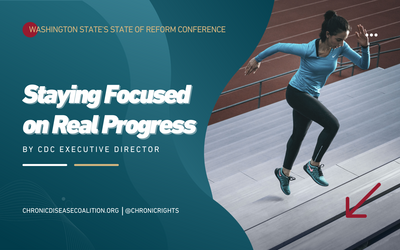
By CDC Executive Director, Mary Kay Clunies-Ross

Last week, I went to Washington state's State of Reform conference, a popular event for connecting with others in healthcare. It was great to see old friends, meet new ones and hear interesting panelists. Many important topics were taken up, including social media and public health, rural healthcare and the federal and state legislative outlooks.
The discussion about mis- and dis-information in health information was especially attention-getting, as it has very scary ramifications for patients. Chronic disease patients are often managing multiple diseases, and are in general more dependent on their communities being healthy.
A few startling stats:
- In 2021: only 12 social media accounts were responsible for 65% of anti-vaccine social media posts*
- 8 out of 10 people believed or were unsure about false statements about COVID and vaccines.*
But the end of the conference, at the end of every day, the central question remains: how do we help people be healthier and live better?
All the quality metrics and regulations in the world aren't going to change the fact that Americans are just living sicker than they used to. It’s so easy to point fingers at the institutions within the healthcare system. Down with insurance companies! Down with government intervention! Down with systems! The problem of finger-pointing is that the healthcare system is constantly balancing three values and we can’t get them all at the same time: quality, access and cost. Quality and access cost money; access to affordable care is often lower quality; affordable, quality care isn't broadly available. There are some essential paradoxes:
- By most metrics, we do have better health care than we did 20 years ago— fewer uninsured, better treatments, more vaccines, more transparency, less time in hospitals, higher survival rates for common diseases, more emphasis on preventive care and early intervention. There's a lot of progress in terms of life-saving healthcare delivery, and not just in Washington state.
- Many, many patient health problems aren't related to the healthcare system at all. We’re sick (and sicker) long before we get into the doctor’s office. So many of us are managing worse air, worse water, longer work hours, more stress, more inter-generational caretaking, more economic uncertainty, worse nutrition, more grief... we are all more complex, and generally sicker. Also, our population includes less-than-fully-healthy people who are alive because they received life-saving care from the medical system.
We wrote about the Washington Post’s important series about American's life expectancy, as this is very much about the growing number of chronic disease patients (Report: Chronic Diseases are Taking Away Years of Quality Life). The Post did a great job of showing the complexity of the problem: we have a market-based delivery system expected to provide high quality services to every individual, regardless of their ability to pay, and a nation that is increasingly sick anyway.
We have both people who are living sick due to poor nutrition, stress, environmental and socio-economic factors, and we have people who are living sick due to health care success. For example: While I was at conference to talk to a woman with a genetic condition that led to a successful heart transplant and what will be a lifetime’s worth life-saving medication. The transplant and medication are expensive, but she’s likely to have two or three more decades of life. That’s amazing.
How do these big system issues translate to patient-centered policy-making?
Good question. At the reform conference, people were talking about patient-centered care, and that’s important. But for that to happen, you have to have patients at the table and an unrelenting focus on reforms that make change at the patient-and-provider level. Chronic disease patients especially need robust insurance networks, predictable pricing, coverage for physician-prescribed treatments, and investments in the next generation of diagnostic and treatment tools.
It also means we must continue building a more equitable and just society and support patients with non-medical health costs like transportation, childcare, paid time off, housing, and affordable, nutritious food.
The CDC has developed a values-based policy platform this year, focusing on those issues that most directly impact patients. Check out those policies here, and then take the next step: tell your elected officials what your patient experience has been.
*https://252f2edd-1c8b-49f5-9bb...
*https://www.kff.org/coronavirus-covid-19/poll-finding/kff-covid-19-vaccine-monitor-media-and-misinformation/